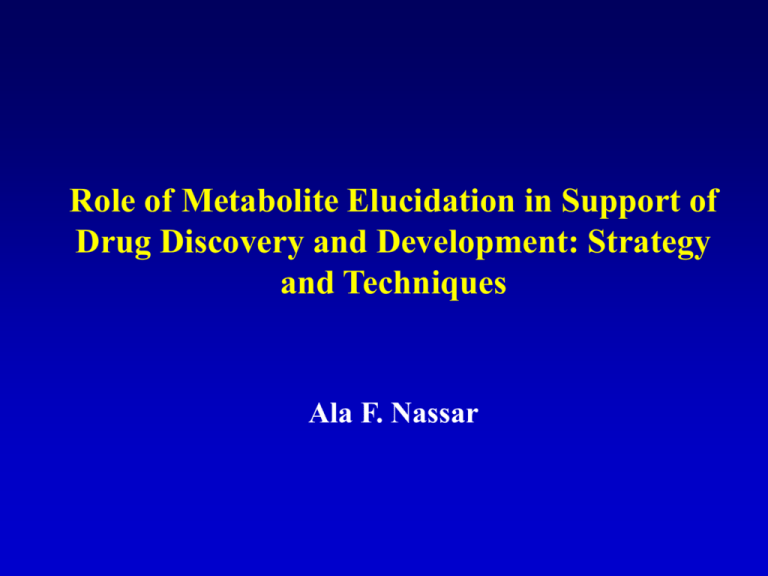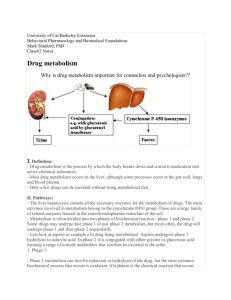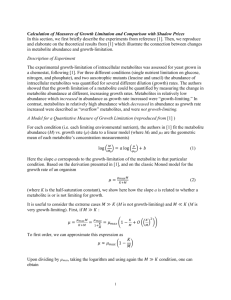Pres
advertisement

Role of Metabolite Elucidation in Support of Drug Discovery and Development: Strategy and Techniques Ala F. Nassar Today’s Topics • • • • • • Introduction Utilization of in-silico methods and automation techniques for rapid metabolite elucidation Online H-D exchange method Presentation of technique capable of detection down to 20 cpm 14C peaks Using stable isotopes for metabolite elucidation Case studies Questions for Drug Metabolism Scientists • What are the chemical reactions involved in the • • • • metabolism of foreign compounds? Where do these reactions take place in the body? Which enzyme systems catalyze the metabolism of foreign compounds? What are the biochemical mechanisms of these processes? What are the biological consequences of xenobiotic metabolism? Outcome Guiding drug candidate selection by taking advantage of metabolic reactions to design more effective and safer drugs Typical Screening Cascade In Vitro Enzyme Assay Cell Based Assay Selectivity In parallel or In series Exposure screening Microsomal stability Metabolites ID IV/PO PK studies CYP inhibition screening Caco-2 permeability solubility Expanded PK (definitive, TK, formulations, etc.) Chronic efficacy model Acute in vivo efficacy model Select Drug Candidate Techniques for ADME Studies • • • • • • • • Microsomal Stability Hepatocyte Stability Caco-2 Permeability Metabolic Profiling Protein Binding Whole Body Autoradiography P450 Inhibition and Induction Pharmacokinetic Analysis • Metabolite Elucidation Significance of Metabolite Elucidation • Assistance with chemical synthesis efforts to block or enhance metabolism • Prediction of metabolites likely to be formed in • • • • vivo Determination of metabolic differences between species Identification of potential pharmacologically-active or -toxic metabolites Synthesis of metabolites for toxicology testing Prediction of drug-drug interactions Method for Characterization of Metabolites in Drug Discovery Utilizing in-silico Prediction, GENESIS Workstation and QTOF-MS The automated assay system consists of: Pallas MetabolExpert software to predict possible metabolites Robotic liquid handler (Genesis workstation) to generate and process samples QTOF-MS coupled with liquid chromatography to analyze samples MetaboLynx software to find potential metabolites Exact mass measurement to help for Met ID Advanced Chemistry Development/MS (ACD/MS) software to predict hypothetical metabolite chemical structures SELECTED COMPOUNDS TO EXAMINE NOVEL METHODS/TOOLS FOR MET ID O OH N H O N Dextromethorphan Propranolol NH O OH Alprenolol Prediction of possible metabolites for propranolol using Pallas MetabolExpert 10.0 software N-dealkylation Conjugation O N N-oxidation O Aromatic Oxidation or Epoxidation Propranolol O-dealkylaton Prediction of possible metabolites for propranolol using Pallas MetabolExpert 10.0 software O O O O O N O N N O O O O O O N O O N O N O O O O O N O O N O N O O O Propranolol O O N O O O O O N N N N O O O O O O O O TOF-MS/MS spectrum of (A) dextromethorphan and (B) dextromethorphan-M1 213 -2H -C3H7N 215 199 -4H 147 -2H 201 -C3H7N -C3H9N 198 OH O N N 121 -CH2O -CH2 173 107 91 159 159 -H2 -H2 171 [M+H]+, 157 [M+H]+, m/z 272 145 -C2H2 133 m/z 258 TOF MSMS 272.00ES+ 171.1 100 -CH2 147.1 A 213.1 % 159.1 198.1 121.1 272.2 135.1 91.1 181.1 0 TOF MSMS 258.00ES+ 157.1 100 B 133.1 199.1 % 145.1 107.1 121.1 0 80 100 120 258.2 171.1 185.1 140 160 180 200 220 240 260 m/z 280 TOF-MS/MS spectra of (A) propranolol and (B) propranolol-M1 98 218 -H2O -H2O 98 183 234 -H2O -H2O OH 116 N 116 H 199 OH N H O O 157 -2H 129 145 155 -C3H7 OH -C3H7 165 171 181 [M+H]+, m/z 276 [M+H]+, m/z 260 TOF MSMS 260.00ES+ 116.1 100 173 -2H 155.1 183.1 A % 98.1 129.1 165.1 260.2 141.1 86.1 218.2 0 TOF MSMS 276.00ES+ 116.1 100 173.1 199.1 B % 98.1 145.1 86.1 181.1 276.2 161.1 234.2 128.1 1 80 100 120 140 160 180 200 220 240 260 m/z 280 ACD/MS software as efficient tool to help in assigning potential metabolite chemical structure The ACD/MS software was used to help determine the chemical structures for the metabolites. We performed the following steps to produce a potential (hypothetical) metabolite chemical structure for each of our test compounds: Generate the MS/MS spectrum for each metabolite; Attach the corresponding potential (hypothetical) structure(s) to it; Run Autoassign; Use ACD/MS software to provide a score for percent of spectrum assignment; These scores then guided us to the most likely form for the potential (hypothetical) chemical metabolite structure. To speed up the process, we ran autoassign in batch mode on the various metabolite possibilities for each particular molecule. We were able to increase the intelligence of the process by using accurate mass data. Mass accuracy measurements of selected drugs and their metabolites, the exact mass difference between each metabolite and parent drug Substrate Molecular Formula Mass, m/z Theoretical Mass Measured Massa Mass Error, Da SD, Da ppm Exact Mass Differencea,b Dextrom1 M-1 M-2 M-3 C18H26NO C17H24NO C16H22NO C17H24NO 272.2014 258.1858 244.1706 258.1858 272.2012 258.1868 244.1707 258.1862 0.0002 0.0010 0.0001 0.0004 0.0008 0.0002 0.0010 0.0013 0.7 3.8 0.4 1.5 -14.0146 28.0307 14.0152 Propranolol M-1 M-2 M-3 C16H22NO2 C16H22NO3 C16H22NO3 C16H22NO3 260.1651 276.1600 276.1600 276.1600 260.1649 276.1601 276.1602 276.1602 0.0002 0.0001 0.0002 0.0002 0.0005 0.0009 0.0009 0.0006 0.7 0.3 0.7 0.7 -15.9950 15.9951 15.9951 Alprenolol M-1 M-2 C15H24NO2 C15H24NO3 C15H24NO3 250.1807 266.1756 266.1756 250.1808 266.1763 266.1752 0.0001 0.0007 0.0004 0.0007 0.0015 0.0003 0.3 2.6 1.5 -15.9956 15.9945 1 Dextromethorphan Avg. of 5 injections. b Exact mass difference between each metabolite and parent drug, theoretical mass of CH2 is 14.0157 Da, C2H4 is 28.0313 Da, and oxygen is 15.9949 Da. a Pallas software was useful in predicting the possible metabolic fate of the compounds examined Compound Molecular Formula Pallas ACD Dextromethorphan Dextromethorphan-M1 Dextromethorphan-M2 Dextromethorphan-M3 C18H26NO C17H24NO C16H22NO C17H24NO -Yes Yes Yes n=7 -88 98 88 Propranolol Propranolol-M1 Propranolol-M2 Propranolol-M3 C16H22NO2 C16H22NO3 C16H22NO3 C16H22NO3 -Yes Yes Yes -82 86 71 n=15 Alprenolol Alprenolol-M1 Alprenolol-M2 C15H24NO2 C15H24NO3 C15H24NO3 -Yes Yes n=11 -58 61 Proposed metabolic pathways of dextromethorphan in hepatic microsomal incubations based on MS/MS and ACD data O N O-demethylation N-demethylation Dextromethorphan m/z 272 OH O N N H O-demethylation Methoxymorphinan, M-3 [M+H]+ m/z 258 N-demethylation OH N H Hydroxymorphinan, M-2 [M+H] + m/z 244 Dextrorphan, M-1 [M+H]+ m/z 258 Proposed metabolic pathways of propranolol in hepatic microsomal incubations based on MS/MS and ACD data OH N H O Propranolol [M+H]+ m/z 260 [O] [O] [O] OH OH OH N N N H H H O O O HO OH OH Monohydroxy propranolol, M-1 [M+H]+ m/z 276 Monohydroxy propranolol, M-2 [M+H]+ m/z 276 Monohydroxy propranolol, M-3 [M+H]+ m/z 276 Proposed metabolic pathways of alprenolol in hepatic microsomal incubations based on MS/MS and ACD data NH O OH Alprenolol [M+H]+ m/z 250 [O] [O] OH HO NH O OH Monohydroxy-Alprenolol, M-1 [M+H]+ m/z 266 NH O OH Monohydroxy-Alprenolol, M-2 [M+H]+ m/z 266 CONCLUSIONS Pallas is a useful software tool to predict possible metabolites The QTOF mass spectrometer generates accurate MS data (high resolution) which can rapidly identify metabolites when combined with MetaboLynx software MetaboLynx software is useful to automatically find potential metabolites, avoiding time-consuming data analysis ACD software is useful to assist in the mass spectral data interpretation, leading to tentative structures for the proposed metabolites in drug discovery The major metabolites were found in rat and human liver microsomal preparations and were in good agreement with previously published results Hydrogen-deuterium Exchange and QTOF-MS for Metabolite Elucidation in Drug Metabolism H-D exchange methods are useful for determination of: • N- or S-oxide formation and mono- hydroxylation • Conjugation such as glucuronidation • Dehydrogenation or dealkylation Prediction of possible metabolites for Nimodipine using Pallas software 9 1. 2. 3. 4. 5. 6. 7. 8. 9. Cleavage Cleavage Cleavage Hydroxylation Hydroxylation Cleavage Cleavage Hydroxylation Cleavage O+ N O 3 O O 8 O 7 O O N 1 6 H* 2 4 5 Exchange of labile hydrogens in nimodipine and metabolites formed in-vitro Compound Labile Hydrogen Mass 1 [MH +H]+, m/z Nimodipine M-1 M-2 M-3 M-4 M-5 1 1 2 1 2 0 419 359 435 403 405 417 1 MH=the molecular weight in H2O MD=the molecular weight in D2O 2 Mass [MD2+D]+, m/z predicted measured 421 361 438 405 408 418 421 361 438 405 408 418 Proposed metabolic pathways of nimodipine in hepatic microsomal incubations in H2O O + N O O O O O O N H CH2OH [MH+H]+ m/z 435 M-2 O O + N O O + N O O O O HO O O O O N N O H H + [MH+H]+ m/z 419 Nimopdipine N O HO O O O N C H O O O H O [MH+H]+ + N [MH+H]+ m/z 405 M-4 O O m/z 359 M-1 + N O O O O H O O O O O O N N [MH+H]+ m/z 417 M-5 [MH+H]+ m/z 403 M-3 Proposed metabolic pathways of nimodipine in hepatic microsomal incubations in D2O O + N O O O O O O N D CH2OD [MD+D]+ m/z 438 M-2 O O + N O O + N O O O O DO O O O O N D + [MD+D] m/z 421 Nimopdipine N O O DO O O O O N C H O O O H O [MD+D]+ + N D [MD+D]+ m/z 408 M-4 + N O m/z 361 M-1 + N O O O O DO O O O O O N N [MD+D]+ m/z 418 M-5 [MD+D]+ m/z 405 M-3 CONCLUSIONS • One advantage of the H-D exchange method is that, with LC-MS/MS, it offers an easy estimation of the number of labile hydrogen atoms in such groups as -OH, -NH, -NH2 and -COOH • This number is useful in comparing the metabolite structure with that of the parent drug to determine the presence or absence of the above groups • H-D exchange experiments have facilitated structural elucidation and interpretation of fragmentation processes as well • Our results indicated that this method should be particularly desirable for identification of metabolites produced by dehydrogenation, oxidation, and dealkylation NOVEL APPROACH TO PERFORMING METABOLITE IDENTIFICATION IN DRUG METABOLISM AIMS • Validate capability of on-line radioactivity detector coupled with MS to measure radiolabeled compounds • Enhance the sensitivity of radioisotope measurement for metabolite identification LC-ARC-MS-FC System PC Sampler Column Agilent 1100 Pump StopFlow Controller Packard 500 Detector Waste LCQ MS Cocktail Fraction Collector Laptop PC ARC Data System ARC Control Lines LCQ Control Lines Linearity of DynamicFlow Radioactivity Detection 700 y = 1.1213x - 50.702 2 R = 0.996 Peak Area Peak Area (DPM) 600 500 400 Detected DPM Linear (Detected DPM) 300 200 100 0 0 200 400 Applied DPM DPM Applied 600 800 HPLC-MS chromatograms of [14C]dextromethorphan following incubation with HLM in the presence of NADPH showing M-1, M-2, M-3 and dextromethorphan RT: 0.00 - 32.00 SM: 15G NL: 1.10E6 m/z= 273.00-275.00 F: ITMS + c ESI Full ms [ 200.00-300.00] MS HLM-C14-60min 20.52 100 50 3.16 3.86 0.44 0 100 7.16 9.77 12.29 14.05 15.82 16.71 12.40 19.48 21.03 22.17 24.58 26.46 28.23 31.59 NL: 4.28E5 m/z= 257.95-258.52 F: ITMS + c ESI Full ms [ 200.00-300.00] MS HLM-C14-60min 12.34 12.50 50 0.16 0 100 3.01 4.02 5.95 7.45 9.31 12.58 15.28 12.22 19.09 21.76 22.03 22.26 25.08 26.97 28.38 31.58 NL: 4.54E4 m/z= 243.00-245.00 F: ITMS + c ESI Full ms [ 200.00-300.00] MS HLM-C14-60min 13.35 50 3.03 0 100 3.13 3.35 7.41 9.40 11.24 12.78 13.88 21.26 22.15 23.85 25.54 27.85 21.89 17.76 18.60 31.58 NL: 5.91E5 m/z= 260.00-262.00 F: ITMS + c ESI Full ms [ 200.00-300.00] MS HLM-C14-60min 50 3.01 3.71 5.31 0.44 0 0 2 4 6 8.33 9.74 12.15 12.41 8 10 12 22.26 15.34 16.79 18.91 19.85 14 16 18 Time (min) 20 22 23.39 25.83 28.03 24 26 28 31.58 30 LC-MS spectra of [M+H]+ m/z 274, nonmetabolized [14C]dextromethorphan, (A) MS2, (B) MS3 and (C) MS4 following incubation of [14C]dextromethorphan with HLM dex274 #237-272 RT: 0.63-0.72 AV: 36 NL: 1.58E6 F: ITMS + c ESI Full ms2 274.00@50.00 [ 75.00-300.00] 217.12 1400000 1200000 Intensity 1000000 800000 600000 215.14 400000 149.03 200000 0 83.00 90.99 80 122.97 148.26 120 140 109.05 100 161.06 175.07 160 201.11 214.32 180 200 231.16 220 243.12 256.23 240 274.22 260 280 300 m/z dex274 #383-419 RT: 1.09-1.22 AV: 37 NL: 5.88E5 F: ITMS + c ESI Full ms3 274.00@50.00 217.00@50.00 [ 55.00-300.00] 148.98 550000 500000 450000 Intensity 400000 350000 300000 175.02 250000 200000 161.00 150000 100000 122.94 50000 136.99 68.92 0 60 80.93 80 92.91 100 120 189.04 163.01 106.97 140 160 180 m/z 198.13 200 220 240 260 280 300 dex274 #701-736 RT: 2.55-2.70 AV: 36 NL: 3.56E4 F: ITMS + c ESI Full ms4 274.00@50.00 217.00@50.00 149.00@50.00 [ 50.00-150.00] 90.88 35000 30000 Intensity 25000 20000 15000 120.97 10000 131.98 5000 118.94 92.90 54.88 0 50 106.91 94.99 60 70 80 90 100 m/z 110 114.97 130.97 129.82 120 130 133.99 149.04 140 150 201 -CH2 215 -2H 217 -C3H7N O * CH3 121 N 123 175 -*CH2O 123 149 -C2H2 [M+H]+, m/z 274 [14C]dextromethorphan *=C14 -2H 91 -C2H2 Proposed metabolic pathways of dextromethorphan in hepatic microsomal incubations O * CH3 N N-demethylation O O-demethylation Dextromethorphan [M+H]+ m/z 274 OH *=C14 * CH3 N Dextrorphan [M+H]+ m/z 258 N H Methoxymorphinan [M+H]+ m/z 260 O-demethylation OH N H Hydroxymorphinan [M+H]+ m/z 244 N-demethylation CONCLUSIONS This system detects 14C peaks down to 6 cpm, about 20 times more sensitively than commercially available flow-through radioactivity detectors The LC-ARC on-line stop-flow method detects 3H peaks up to 10 times more sensitively than commercially available flow-through radioactivity detectors On-line mass spectrometer data were acquired Using this method, it is possible to generate high resolution radiochromatograms, accurately measure volatile metabolites which fraction-collection methods are not even able to detect, and acquire mass spectra on-line An important safety benefit is that, by using this method, we reduced sample injection size, thus reducing radioactivity exposure and wastes Stable Isotope Approach for Metabolite Elucidation in Drug Metabolism Case Studies Considerations to Enhance Metabolic Stability. One of the most important keys to successful drug design and development is a process of finding the right combination of multiple properties such as activity, toxicity and exposure. Optimize these three properties for drug candidates, and thus their suitability for advancement to development. The responsibility of the drug metabolism scientist is to optimize plasma T1/2 (clearance compound), drug/metabolic clearance, metabolic stability, and the ratio of metabolic to renal clearance. Another concern is to minimize or eliminate the following: • gut/hepatic-first-pass metabolism, • inhibition/induction of drug-metabolizing enzymes by metabolites, • biologically active metabolites, • metabolism by polymorphically expressed drug-metabolizing enzymes • formation of reactive metabolites. Advantages of Enhancing Metabolic Stability Increased bioavailability and longer half-life, which in turn should allow lower and less frequent dosing thus promoting better patient compliance. Better congruence between dose and plasma concentration, thus reducing or even eliminating the need for expensive therapeutic monitoring. Reduction in metabolic turnover rates from different species which, in turn, may permit better extrapolation of animal data to humans. Lower patient-to-patient and intra-patient variability in drug levels, since this is largely based on differences in drug metabolic capacity. Diminishing the number and significance of active metabolites and thus lessening the need for further studies on drug metabolites in both animals and man. Strategies to Enhance Metabolic Stability In general, metabolism can be reduced by incorporation of stable functions (blocking groups) at metabolically vulnerable sites. Substrate structure activity relationships of metabolizing enzymes have to be accommodated within the structure activity relationships of the actual pharmacological target. The following strategies have been used: • Deactivating aromatic rings towards oxidation by substituting them with strongly electron withdrawing groups (e.g., CF3, SO2NH2, SO3-). • Introducing an N-t-butyl group to prevent N-dealkylation. • Replacing a labile ester linkage with an amide group. • Constraining the molecule in a conformation which is unfavorable to the metabolic pathway, more generally, protecting the labile moiety by steric shielding • The phenolic function has consistently been shown to be rapidly glucuronidated. Thus, avoidance of this moiety in a sterically unhindered position is advised in any compound intended for oral use. Strategies to Enhance Metabolic Stability (cont’d) • Avoidance of other conjugation reactions as primary clearance pathways, would also be advised in the design stage in any drug destined for oral usage. • Sometimes the best strategy is to anticipate a likely route of metabolism and prepare the expected metabolite if it has adequate intrinsic activity. For example, often N-oxides are just as active as the parent amine, but won't undergo further Noxidation. Examples from literature to enhance metabolic stability in the molecular design Reduce the overall lipophilicity (logP, logD) of the structure H N O O O N O N N H O N H O O EC50 = 0.078mM, clogP = 2.07, C7hr = 0.012mM F F O H N EC50 = 0.058mM, clogP = 0.18, C7hr = 0.057mM O O N O N H N O N H O O Dragovich, P. et al (2003). Journal of Medicinal Chemistry, 46(21), 4572-4585. Remove or block the vulnerable site of metabolism (Benzylic oxidation) N Br N O Ki = 66 nM, AUC 0-6h = 40 ng/ml hr O O N N _ O Br N N N Br N N O O Ki = 2.1 nM, AUC 0-6h = 6500 ng/ml hr Ki = 2 nM, AUC 0-6h = 1400 ng/ml hr Palani, A. et al (2001) Journal of Medicinal Chemistry, 44(21), 3339-3342. + Remove or block the vulnerable site of metabolism (Allylic oxidation) N NH2 N IC50 = 0.06 mg/ml, Cmax = 14-140 ng/ml O S O N NH2 N O S O IC50 = 0.02 mg/ml, Cmax = 70-300 ng/ml Victor F et al (1997). Journal of medicinal chemistry, 40(10), 1511-8. Remove or block the vulnerable site of metabolism (Glucuronidation) Effect of linker OH O O O NH2 N NH2 N OH F O F UDPGA rate (nmol/min/mg protein) = 0.19, t1/2 = 4.7 hr UDPGA rate (nmol/min/mg protein) = 0.05, t1/2 = 5.5 hr Effect of template OH OH O S NH2 N O F NH2 N O F UDPGA rate (nmol/min/mg protein) = 0.05, t1/2 = 5.5 hr UDPGA rate (nmol/min/mg protein) = 0.012, t1/2 = 14.5 hr Effect of stereochemistry OH OH O O O NH2 N O F UDPGA rate (nmol/min/mg protein) = 0.02, t1/2 = 7.7 hr O NH2 N O F UDPGA rate (nmol/min/mg protein) = 0.01, t1/2 = 8.7 hr Bouska J J. et al (1997) Drug metabolism and disposition: biological fate of chemicals, 25(9), 1032-8. Examples to improve PK properties through structural modification of drug candidates Minimize First-pass effect/prodrug approach •Oral dosage of propranolol (Hasegawa et al 1978) produces a low bioavailability and a wide variation from patient to patient when compared to intravenous administration; this difference is attributed to first-pass elimination of the drug. •Hemisuccinate ester of propranolol was selected as a potential prodrug with the hypothesis that propranolol hemisuccinate ester administration would avoid glucuronide formation during absorption and subsequently be released in the blood by hydrolysis. COOH HO Propranolol + O Hydrolysis O OH N H N H O O COOH Glucuronidation O Propranolol AUC 0-6 = 132 ng/ml.h Hemisuccinate ester of propranolol AUC 0-6 = 1075 ng/ml.h Examples to improve PK properties through structural modification of drug candidates (cont’d) Half-life •ABT-418, an analogue of (S)-nicotine in which the pyridine ring is replaced by the 3methyl-5-isoxazole moiety, has been shown to possess cognitive-enhancing and anxiolyticlike activities in animal models with an improved safety profile compared to that of nicotine (Lin et al. 1997). •One shortcoming of ABT-418 was its very poor bioavailability (%F = 1.2), with a short plasma half-life (t1/2 = 0.21 h). Research on structural modification led to the identification of ABT-089, 2-Methyl-3-(2(S)-pyrrolidinylmethoxy)pyridine, with a vastly improved oral bioavailability (%F = 61.5) with t1/2 = 1.6 h. O N N N H O N 5 pyrollidine ABT-418 t1/2 = 0.2 h ABT-089 t1/2 = 1.6 h Conclusions In-silico and in vitro techniques are available to screen compounds for key ADME characteristics. Structural information on metabolites is a great help in enhancing as well as streamlining the process of developing new drug candidates. By improving our ability to identify both helpful and harmful metabolites, suggestions for structural modifications will optimize the likelihood that other compounds in the series are more successful. Structural modifications to solve a metabolic stability problem may not necessarily lead to a compound with an overall improvement in PK properties. Solving metabolic stability problems at one site could result in the increase in the rate of metabolism at another site, a phenomenon known as metabolic switching. Further, reduction in hepatic clearance may lead to increased renal or biliary clearance of a parent drug or inhibition of one or more drug-metabolizing enzymes. Therefore, it is advisable that in vitro metabolic stability data be integrated with other ADME screening. Conclusions (cont’d) An accurate measurement of the pharmacokinetic parameters and a good understanding of the factors that affect the pharmacokinetics will guide drug design. High metabolic liability usually leads to poor bioavailability and high clearance, and formation of active or toxic metabolites will have an impact on the pharmacological and toxicological outcomes. Drug candidates should have little or none of the following: •gut/hepatic-first-pass metabolism •inhibition/induction of drug-metabolizing enzymes •biologically active metabolites •metabolism by polymorphically expressed drug-metabolizing enzymes •formation of reactive metabolites •Also, it is important to have the most desirable plasma half-life and ratio of metabolic to renal clearance.






